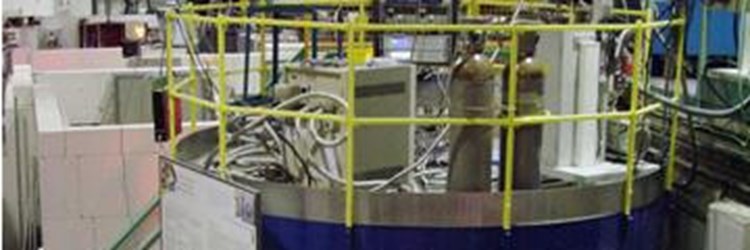

IN13 is a unique spectrometer at a high flux reactor devoted to the study of the internal macromolecular dynamics
IN13 is currently a unique spectrometer at a high flux reactor to permit the exploration of the 100 picosecond time scale window with a scattering vector modulus Q going up to ~5 Å-1. The large Q range attainable is very useful to discriminate between different motion geometries in the sample. In fact, unlike back-scattering spectrometers with energy resolution of ~1μeV, the lower resolution on IN13 makes it relatively insensitive to global diffusion, allowing internal motions to dominate the data. It makes it also relatively insensitive to scattering by water diffusion.
IN13 is a backscattering spectrometer working with thermal neutrons with wavelength 2.23 Ǻ corresponding to energy of 16.45 meV. The variation of the incident neutron energy is obtained by adjusting the d-spacing of the monochromator by heating/cooling it. The energy resolution is of the order of 8 μeV and the energy window is ± 150 μeV, corresponding to a time scale ranging from 10- 12 s to 10-10 s. The neutrons leaving the guides are selected in energy by a CaF2 monochromator and then reflected by a pyrolytic graphite deflector to finally reach the sample through a chopper device. The beam dimension at the sample position is defined by a double-slit system. The beam scattered from the sample is reflected in almost perfect backscattering geometry by CaF2 analysers mounted on spherically/circularly curved Al plates, to be finally collected by 35 He3 gas counter detectors and a position-sensitive detector for the medium-large and small scattering angles, respectively. The background noise is minimized through the insertion of a conic collimator covered with gadolinium paint. The instrument fills the energy gap between IN10 or IN16 and IN5 at ILL, MIBEMOL at the LLB or IRIS at the Rutherford-Appleton laboratory (RAL) in United-Kingdom. In addition the value of the incident energy gives the availability of high momentum transfers (Q < 4.9 Å-1, extendable to 5.5 Å-1), much larger than obtainable with the above-mentioned spectrometers.
In the framework of the ILL Endurance project, the instrument will benefit of a substantial upgrade, which includes mainly two major issues:
Applications are found in biology, medical science, chemistry, cultural heritage, etc. Among them:
National:
International: